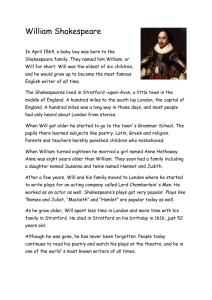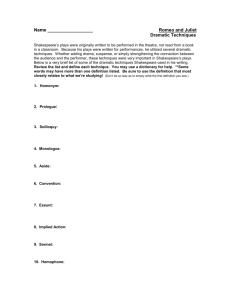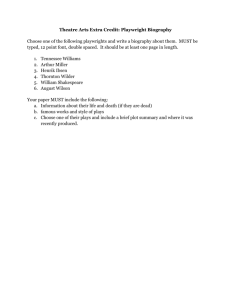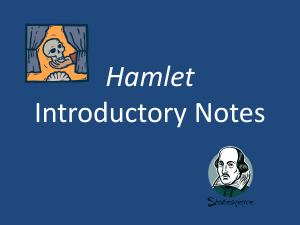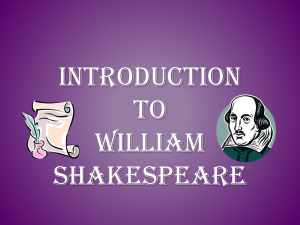NBB AN128 K1 History of English Literature 1. DP (1) From Anglo
advertisement
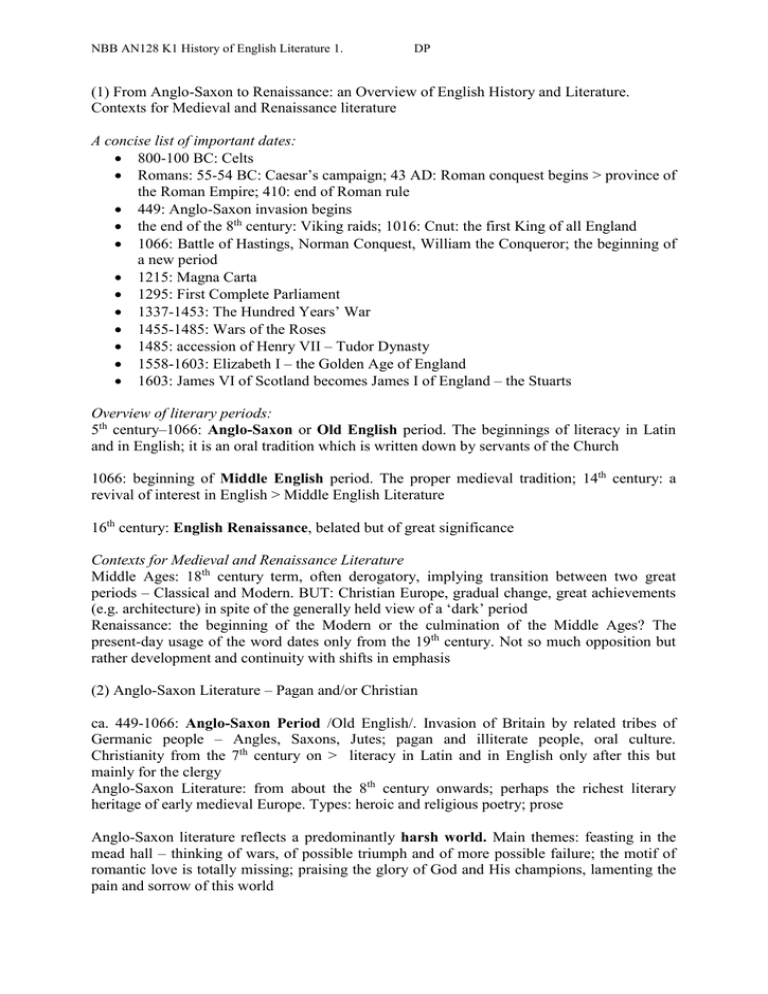
NBB AN128 K1 History of English Literature 1. DP (1) From Anglo-Saxon to Renaissance: an Overview of English History and Literature. Contexts for Medieval and Renaissance literature A concise list of important dates: 800-100 BC: Celts Romans: 55-54 BC: Caesar’s campaign; 43 AD: Roman conquest begins > province of the Roman Empire; 410: end of Roman rule 449: Anglo-Saxon invasion begins the end of the 8th century: Viking raids; 1016: Cnut: the first King of all England 1066: Battle of Hastings, Norman Conquest, William the Conqueror; the beginning of a new period 1215: Magna Carta 1295: First Complete Parliament 1337-1453: The Hundred Years’ War 1455-1485: Wars of the Roses 1485: accession of Henry VII – Tudor Dynasty 1558-1603: Elizabeth I – the Golden Age of England 1603: James VI of Scotland becomes James I of England – the Stuarts Overview of literary periods: 5th century–1066: Anglo-Saxon or Old English period. The beginnings of literacy in Latin and in English; it is an oral tradition which is written down by servants of the Church 1066: beginning of Middle English period. The proper medieval tradition; 14th century: a revival of interest in English > Middle English Literature 16th century: English Renaissance, belated but of great significance Contexts for Medieval and Renaissance Literature Middle Ages: 18th century term, often derogatory, implying transition between two great periods – Classical and Modern. BUT: Christian Europe, gradual change, great achievements (e.g. architecture) in spite of the generally held view of a ‘dark’ period Renaissance: the beginning of the Modern or the culmination of the Middle Ages? The present-day usage of the word dates only from the 19th century. Not so much opposition but rather development and continuity with shifts in emphasis (2) Anglo-Saxon Literature – Pagan and/or Christian ca. 449-1066: Anglo-Saxon Period /Old English/. Invasion of Britain by related tribes of Germanic people – Angles, Saxons, Jutes; pagan and illiterate people, oral culture. Christianity from the 7th century on > literacy in Latin and in English only after this but mainly for the clergy Anglo-Saxon Literature: from about the 8th century onwards; perhaps the richest literary heritage of early medieval Europe. Types: heroic and religious poetry; prose Anglo-Saxon literature reflects a predominantly harsh world. Main themes: feasting in the mead hall – thinking of wars, of possible triumph and of more possible failure; the motif of romantic love is totally missing; praising the glory of God and His champions, lamenting the pain and sorrow of this world NBB AN128 K1 History of English Literature 1. DP Style: special vocabulary – synonyms, repetitions; alliterative verse (lines of four stresses and varying number of unstressed syllables, divided into two half-lines of two stresses by a marked caesura, linked by alliteration of stressed words.) / x x / (x) || / x x / ‘Bid man of battle build me a tomb / x x / || x x / x x x / fair after fire, on the foreland by the sea Heroic poetry: this has the closest connection with the Germanic origin of the invaders. Subject matter is drawn from earlier times, often from the common stock of Germanic heroes. The Germanic heroic society shows resemblances to the Hellenic world of Homer – nations are seen as groups of people related by kinship, the tribe is ruled by a chieftain called king, the king leads his men in battle, rewarding them afterwards, in return the retainers fight for him to the death, if the lord is slain, avenging him or dying in the attempt; blood vengeance, everlasting shame for those neglecting it. This society was already distant from Christian Anglo-Saxon England and difficult to reconcile with Christianity. Nevertheless, Christian poets were fascinated with their pagan ancestors → accommodation – preserving aspects not opposing the Christian ideal, omitting conflicting elements, inserting Christian items. The most important poem: Beowulf (a/the Germanic epic). Religious poetry: by the 8th century techniques of AS heroic poetry were applied to purely Christian themes, consequently much of it is cast in the heroic mood – Anglo-Saxons adapting themselves to the ideals of Christianity and adapting Christianity to their own heroic ideal. (e.g. Christ as a ‘young hero’/The Dream of the Rood/, God as ‘mankind’s Guardian’ /Caedmon’s Hymn/, St Helena as ‘battle-queen’/Elene/.) Anglo-Saxon prose: Latin and English works; King Alfred: the ‘father of English prose’ (3) Middle English Literature 1066: Norman Conquest. Profound changes – the development of feudalism quickened, the Anglo-Saxon nobility was replaced by a French-speaking Norman aristocracy. Three languages were used in England: Latin – in the Church, French as the language of the ruling class, English as the language of the lower classes – it was deprived of a written standard, quickening the natural process of simplification (inflections, declensions lost), borrowing words from French (and Latin). It was the period of French cultural dominance in Europe – the Conquest brought a more immediate and active relationship with it. The 14th century brought a major change: English gainedg ground again (due to the Hundred’ War and the Black Death). From around 1350: Middle English. (1362: English first used at Parliament) The European context: the twelfth-century renaissance (1050 – 1300) – new ways of experiencing the world (love superseding fear, emphasis on the humanity of Christ, the imagery of human passion). Books had increasing significance, the study of Latin and rhetoric became more important, contact was made with the Arab world (Greek philosophy). Chivalry – the code of knight (partly a religious and partly a military institution). Courtly love (fine amour): an important element of literature (a relationship outside marriage, the man is a social equal of the woman but at her service; a well-bred man’s abasement before his lady; her NBB AN128 K1 History of English Literature 1. DP attitude: cold indifference, at best conferring grace on her unworthy supplicant (i.e. a smile or at most, a kiss), yet receiving pledges of his undying service.) Literature: for over two centuries literature produced under courtly or aristocratic patronage was French in tone and language. New developments: lyric (the expression of feelings, emotions and states of mind), romance (narrative poem dealing with the adventures of the knight), fabliau (comic narrative dealing with the lower classes), dream allegory (a story with double levels of meaning, told in the frame of a dream) There were two great developments in the second part of the 14th century: the Alliterative Revival and the work of Geoffrey Chaucer. Alliterative Revival: a revival of the old tradition of alliterative verse with some new developments, in the western and northern parts of England. The Gawain-poet: Sir Gawain and the Green Knight; William Langland: Piers Plowman. (4) Geoffrey Chaucer (ca. 1342-1400) Chaucer: ‘The father of English poetry’; the father of the English language (the London dialect became the literary standard as a result of his work), the culmination of Middle English literature. He was a universal genius – characterised by technical brilliance, knowledge, a wide range of experience and largeness of sympathy. He is the first Humanist in English literature – he brought Humanism to England two centuries earlier than the English Renaissance Life: he was born into an English-speaking merchant family and was trained in courtly life. He had a diplomatic career, visited France and Italy on government service → direct contact with French and Italian literature. Influences: French models at first (dream allegory tradition, Roman de la Rose), later Italian literature had an influence on him – Humanism. He had a very wide range of reading: the Bible, classical works (Antique world), medieval scientific, religious and popular works Early works: dream allegory tradition. Troilus and Criseyde: major work (based on Boccaccio’s Il Filostrato – minor Homeric figures, medievalised Troy), almost like an early novel. The Canterbury Tales: his major work, unfinished; it is a collection of 24 stories of different kinds told by members of a company of pilgrims on their journey from the Tabard Inn in Southwark to Canterbury. (5) The Development of Drama in the Mediaeval Period Medieval English drama originates from Christian liturgy and it has no connection with the drama of Antiquity (the influence of the classical tradition appears only in the Renaissance). It started with the dramatisation of Christ’s life – first as a simple dialogue between the priest and the choir, and later groups of characters acted out the story (as part of the mass). In England it started in the 10th century, with the Easter morning mass. At first these were performed in Latin, with vernacular (English) elements appearing in it. Development: spoken in the choir at first; later the performance was extended down the nave, finally it moved out of the church, first to the churchyard, then to the marketplace or the meadow. Outside the church English replaced Latin, and the story element moved away from the liturgy to use the whole NBB AN128 K1 History of English Literature 1. DP range of sacred history from the Creation to the Last Judgement. Secularisation – paralleled by the physical movement (from sacred to profane), transition from the liturgical drama to mystery and miracle plays (= medieval drama) Types: Mystery plays: dramatized biblical stories. Miracle plays: later development from mystery plays; dramatising saints’ lives and divine miracles, legends of miraculous interventions by the Virgin. Cycles – the story of the Bible from the Creation to the Last Judgement. Performance: guilds, wagons; festivals Morality plays: they do not deal with biblical stories but with personified abstractions of virtues and vices struggling for man’s soul (allegory in drama). Stock elements: the Seven Deadly Sins (Pride, Covetousness / Avarice, Wrath / Anger, Envy, Gluttony, Sloth, Lechery); ‘Dance of Death’ (Death, God’s messenger, comes to summon all). The most well-known play: Everyman (the end of the 15th century) (6) The University Wits: Classical and Native Traditions The most salient aspect of drama in the second part of the 16th century: a shift of interest and emphasis from religious to secular. New themes appeared such as Classical mythology, English and foreign history, presented in new ‘kinds’ (genres) – comedy, history/chronicle play and tragedy. These were plays less about virtues than about people. Much of this was due to the influence of Humanism – the discovery and study of the classics brought the genres of comedy and tragedy. Tragedy was a major development as medieval drama was seen as essentially ‘comic’ (happy ending). The main influence for tragedy was Seneca (playwright and Stoic philosopher, he wrote plays that were intended for reading and not for performance) Professionalisation – actors, authors. Actors were independent groups or servants of wealthy nobleman who dealt exclusively with performances. The first permanent playhouses were opened at the time (1576: the Theatre; others: Curtain, Rose, Swan, Globe). The structure of playhouses derived from innyards – the stage was a large platform, composed of an outer stage and inner stage with an upper stage above the latter; it could symbolically represent any place. There were no actresses; only men were allowed to act, women were played by boys. There were public and private theatres – the former were open-air amphitheatres whereas the latter were indoor halls; there were elements of class distinction as well. There was a great demand for plays – staging 30-40 plays a year, altogether about 250 performances. The audience was standing, a large number of people were crammed together into a small place; there was little or no scenery, there were no scene divisions, the action was performed at a tremendous speed. The audience was mainly illiterate but had remarkable listening capacity. This was an altogether hostile environment – yet there is the supreme sophistication of Elizabethan drama; this is due mainly to the possibility of direct contact with the audience, manipulating the response of the audience by the combinations of the qualities of lyric poetry with narrative form A new literary phenomenon appeared: the secular professional playwright. University Wits: they were writers graduating at Oxford or Cambridge who had no patrons for their literary activities, but they did not want to enter the Church → they turned to playwriting as making a living. They made Elizabethan popular drama more literary and more dramatic; they were the first people to associate English drama permanently with literature. They fused the NBB AN128 K1 History of English Literature 1. DP popular (morality plays) and the learned (the classics) traditions – they used the form of the classicists, and the interest and movement of the popular tradition The most significant representatives: Thomas Kyd and Christopher Marlowe Thomas Kyd (1558-1594): the inventor of ‘romantic tragedy’ – love, conspiracy, murder, revenge; heavy influence of Senecan tragedy. The Spanish Tragedy Christopher Marlowe (1564-1593): the most impressive playwright before Shakespeare; he made great advancements in blank verse and used the most exciting themes of the Elizabethan imagination. The Tragical History of Doctor Faustus (8) The Shakespearean Comedy William Shakespeare (1564-1616): a man of the theatre, a poet, an expert of human passions – characterised by a brilliant handling of stagecraft and the perfect control of his medium; all in all a universal genius of the highest order, with an intuitive understanding of human psychology. He remained perfectly hidden behind his creation Comedy: drama provoking laughter at human behaviour, usually involving romantic love, with a happy ending for the main characters. Shakespeare’s influences: University Wits (mixing folk rituals and courtly elements) and Italian influences (mixing of genres, exotic places and people). Comedy is everywhere in Shakespeare; he never devoted himself exclusively to the writing of comedy; comedies appeared during the whole course of his career. Shakespearean comedy is distinguished by its structure. The starting point is some kind of challenge which presents itself like a blow of fate or sudden turn of fortune’s wheel. Whereas tragedies are centred on an isolated individual, comedies always concern groups of people. The conventional ending is the death of the hero in the tragedy, but there is a double or triple wedding in a comedy. Tragic heroes die without children, but comic figures bind their lives together in marriage, suggesting the possibility of children. The initial calamity arrives without explanation or motive (e.g. a storm). Characters meet this challenge with energy and imagination; they turn fate into providence and fall in love. Groups of contrasting characters are brought through adverse circumstances to a closer and more lasting relationship with one another. There is dramatic irony, word-play and exuberant language, and Shakespeare creates characters of convincing depth and detail Early comedies: The Comedy of Errors, The Taming of the Shrew, The Two Gentlemen of Verona. Transitional: Love’s Labour’s Lost, A Midsummer Night’s Dream, The Merchant of Venice, The Merry Wives of Windsor. Romantic/mature comedies: Much Ado About Nothing, As You Like It, Twelfth Night. Problem plays: Troilus and Cressida, Measure for Measure, All’s Well That Ends Well. Romances: Pericles, Cymbeline, The Winter’s Tale, The Tempest, (The Two Noble Kinsmen – with Fletcher). Problem plays and romances somewhat different – combining elements of comedy and tragedy (9) The Chronicle Plays: Shakespearean History History play: a genre not altogether self-defining or self-explanatory, it emerged in the earlier 16th century from the morality form. History plays were motivated by various factors: Tudor NBB AN128 K1 History of English Literature 1. DP Englishmen had an interest in historical matters, there was commercial pressure (demand for plays with the opening of the permanent theatres; history offered itself as a ready source of plots), the late 16th century was characterised by fear of civil war and anarchy (especially pressing as Elizabeth I did not have an heir) and England was the leading Protestant state in conflict with the great Catholic powers of Counter-Reformation Europe (France, Spain); all these led to tremendous patriotism among all classes (reaching its peak with the defeat of the Spanish Armada in 1588) Shakespeare wrote history plays because of his fascination with politics. History is an exploration of human political behaviour, of desire for power, of man’s response to gaining it and then to being deprived of it. Power in English history meant kingship, so the plays essentially focus on kings as central characters. Shakespeare was preoccupied with the value of order in society – this is already present in his earliest works as well but it becomes the most apparent in the history plays. Shakespeare’s use of history: he selected, shaped, amplified and frequently added to chronicle material in order to intensify the concentration on political issues and on their human consequences (= writing plays and not history) The plays have a political central theme – they are concerned with the gain and loss of power but they move beyond that to attempt a definition of the perfect king. They offer a consideration of kingly virtues and present the psychology of political leaders. The political problem of power is also shown from a moral angle through the influence on society of the moral quality of its leaders. Perhaps the main consideration is the question of legitimacy, that is, the lawfulness of the king, as it is the basis of order in a society English histories and Roman histories. English plays: minor tetralogy – 1, 2 and 3 Henry VI and Richard III; King John; major tetralogy – Richard II, 1 and 2 Henry IV, Henry V; Henry VIII – perhaps in collaboration with Fletcher (10) The Shakespearean Tragedy Tragedy: noble action of noble characters; a noble protagonist in a highly stressful situation leading to a disastrous, usually fatal conclusion. The Shakespearean tragedy: it is the story of one person, encompassing the troubled part of the hero’s life and his death. These plays are stories of exceptional suffering and calamity, which lead to the death of a dominant figure of high social standing – the fate of such a character affects the welfare of a whole nation, his fall produces a sense of contrast between the powerlessness of man and the omnipotence of Fortune or Fate. The characters of the Shakespearean tragedy are exceptional beings, raised much above the average level of humanity but are still human: they have a marked onesidedness, a fatal tendency to identify their whole being with one interest. They demonstrate the nobility of the human spirit – though catastrophic errors are made, these are not motivated by evil – evil actions derive from human weakness as the human being is essentially flawed (in a tragic universe we are all flawed because we are human) Ten plays: Titus Andronicus, Romeo and Juliet, Julius Caesar, Hamlet, Othello, Macbeth, King Lear, Antony and Cleopatra, Coriolanus, Timon of Athens. The Great Tragedies: Hamlet, Othello, King Lear, Macbeth – variations on the theme that humanity’s weaknesses must be recognised as our inevitable fate NBB AN128 K1 History of English Literature 1. DP (11) The Shakespearean Romance Last plays: Pericles, Cymbeline, The Winter’s Tale and The Tempest – problematic status concerning the genre. They are tragicomedies – in the broadest sense of the term as they contain elements of tragedy but have the resolution of comedy; they mix tragic and comic elements in a framework of magic and exoticism – romances These plays share a number of themes such as the separation and reunion of family members and the related idea of exile, the banished characters are restored to their rightful homes at the play’s end and jealousy is involved. The plays stress the need for patience in adversity and the importance of providence in human affairs. Realistic characterisation is relatively weak; the symbolic meaning of characters is more pronounced. There are episodic plots, improbable events and exotic locales, characters are frequently subjected to long journeys and shipwrecks are often involved. There are seemingly magical developments, sometimes real sorcery is present, and various supernatural beings also appear. There is an insistence on the patient acceptance of fate as a necessary element for survival. Shipwrecks reflect the impersonal violence of the sea which is beyond human influence. Characters are passive and helpless, they cannot improve their situations; their strength in adversity is supported by their faith – only providence can bring about the destined resolution through strange turns of fate; the improbability of fate stresses the irrelevance of human desires. Acting with mercy is necessary – revenge for earlier actions is replaced by forgiveness (acknowledging human limitations) (12) The Drama Besides / After Shakespeare: Ben Jonson (and others) Shakespeare and Jonson are the two giants of English Renaissance drama; there are many other playwrights with great works but they remain minor figures compared to Shakespeare and Jonson. Writing for the theatre was a means of gaining popular acclaim and economic satisfaction. Acted plays were really influential; the audience was not large enough to make long runs possible – creating a continuous demand for new plays. Sources of various kinds – anything allowing the presentation of emotional and physical violence, the absurdities and wonders of which a passionate man is capable were good for plays. The period ended in 1642 with the closing of the theatres by the Puritan government – but by that time the form of poetic drama developed by the Elizabethans had completely run its course, there was no further road that way Ben Jonson (1573-1637): he had a claim on the literary men of his time that Shakespeare did not have – Jonson’s plays were more amenable for criticism. Compared to Shakespeare Jonson was more learned, he was deeply concerned with the classical precedent. He used classical models for his plays; he knew in advance of the function of comedy, suiting the humour to it. He is the great example of the Renaissance Humanist turned dramatist and poet. At the same time he was also a rugged Englishman, with a boisterous and even cruel sense of humour. He showed originality even when following classical models. His sardonic view of human nature owed nothing to classical sources; his lyrical gift reflected an important facet of his personality. His most well-known work is Volpone, or the Fox (a satirical comedy) NBB AN128 K1 History of English Literature 1. DP (13) Poetry in the 16th Century The basic assumption of Elizabethan poetry: poetry teaches by delight. It is a poetry which is neither ‘classical’ nor ‘romantic’. A major feature is decorum, that is, a correspondence between the style and the subject matter. Nature is the basis of art – but there is no conflict between them – ‘artificial’ can mean human ingenuity used to enhance nature, improving on something naturally beautiful. Models and conventions have a special importance – originality is not seen as an opposition to tradition, classical models are there to learn from, to transform and to surpass Italian poetry provided examples for English poets – Italian models were used for the reformation of English poetry. Poets translated, borrowed from and imitated Italian poems to restore the combination of flexibility and regularity lost from English during the shift in the stage of the language from Middle English to Modern English in the course of the 15th century. Modes of literature: pastoral, satirical, lyrical, tragic, mythological-erotic, heroic and lyrical. Lyrical: probably the most important mode of literature – because of the sonnet. The sonnet had its main conventions established by Petrarch; several Petrarchan sonnets were translated and used as starting points for English poems. The sonnet sequence also quickly became popular: the sonnet sequence explores contrary states of feeling, a love relationship between poet/lover and an unattainable lady, modelled on medieval courtly love. Sequences: Sir Philip Sidney: Astrophel and Stella; Edmund Spenser: Amoretti. Shakespeare’s sonnets: a belated sequence of 154 poems, changing many elements of the convention (the poems are not ‘wooing’ sonnets, love returned and love unreturned; a triangle of love)

